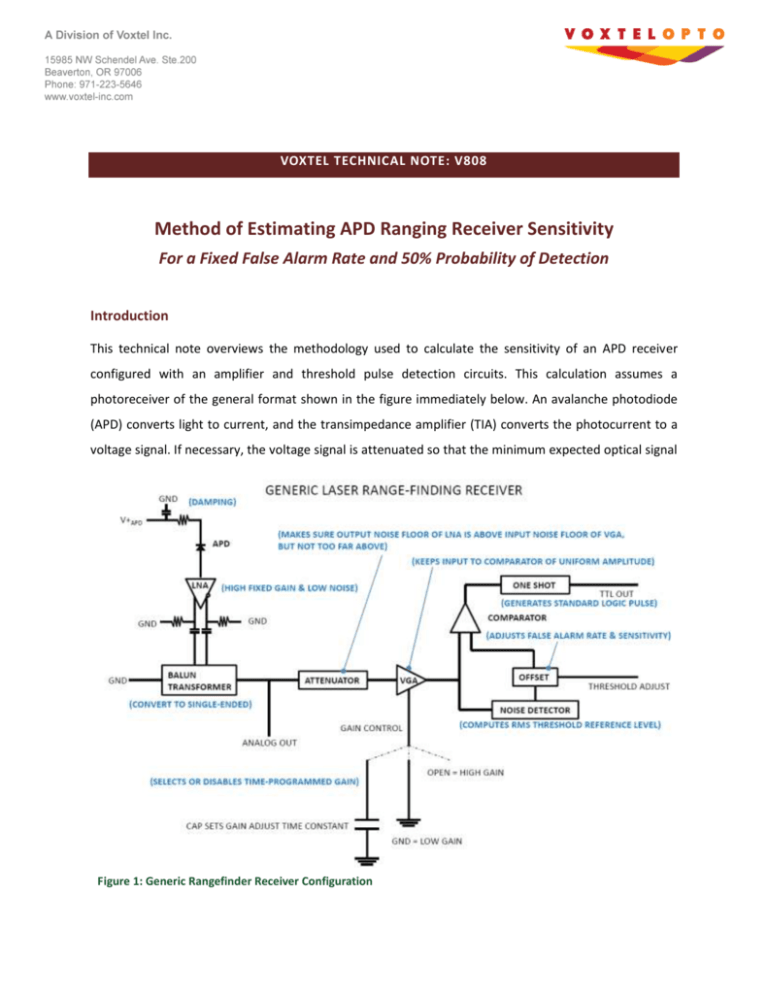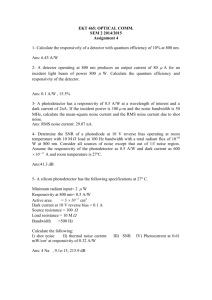V808 -Method of Estimating APD Ranging Receiver Sensitivity
advertisement

VOXTEL TECHNICAL NOTE: V808 Method of Estimating APD Ranging Receiver Sensitivity For a Fixed False Alarm Rate and 50% Probability of Detection Introduction This technical note overviews the methodology used to calculate the sensitivity of an APD receiver configured with an amplifier and threshold pulse detection circuits. This calculation assumes a photoreceiver of the general format shown in the figure immediately below. An avalanche photodiode (APD) converts light to current, and the transimpedance amplifier (TIA) converts the photocurrent to a voltage signal. If necessary, the voltage signal is attenuated so that the minimum expected optical signal Figure 1: Generic Rangefinder Receiver Configuration will be above the input-referred noise floor of the variable-gain amplifier (VGA), but not so far above the VGA’s noise floor as to make inefficient use of the VGA’s dynamic range. The purpose of the VGA is to keep the input level into the comparator more-or-less constant, to help minimize range walk resulting from variation of reflected signal intensity with target range. The idea is for the VGA to implement timeprogrammed gain to perform a 1/R2 correction. (Note, however, that in many cases, the dynamic range of the receiver system will actually be limited by the front end TIA, so the full dynamic range of the VGA will not come into play.) A noise power detector is used to find a reference level for the comparator; it helps to use a threshold relative to the RMS signal level because action of the VGA, or any adjustment to the APD’s gain, could shift the baseline. A user-adjusted offset is added to the baseline threshold reference level to allow adjustment of false alarm rate (FAR). A comparator is used to detect pulses that exceed the threshold, and a ‘one-shot’ converts the output of the comparator into a standardized logic signal that can be timed. Additional support circuitry, not shown, is required to regulate the APD temperature (typically using a thermoelectric cooler) and its high voltage bias. Method We will be calculating the optical signal power at 1550 nm, delivered to the APD’s active area, that is required to achieve 50% pulse detection efficiency with a 0.1% false alarm rate (FAR). This definition of sensitivity can help guide system design, and is also useful for making performance comparisons to other range-finding receiver products. The FAR in Hz can be estimated using the expression for average FAR published in Burle’s Electro-Optics Handbook, Eq. (8-3): FAR I2 exp t 2 , 3 2 In BW (1) where BW is the bandwidth of the receiver, It is a detection threshold expressed as an equivalent current referred to the input of the TIA, and In is the RMS noise current (APD shot noise and circuit noise) also evaluated at the input of the TIA. For instance, assuming a pulse repetition frequency of 10 kHz, a FAR of 10 Hz would be required to achieve a 0.1% false alarm probability per laser shot. If the APD receiver has a bandwidth of ~1 GHz, then a threshold setting about 6× the receiver’s noise level will be required. Voxtel Inc. TECHNICAL NOTE: V808 - Page 2 We estimate receiver sensitivity as a function of bandwidth, for fixed FAR and in the absence of background illumination, by calculating the required ratio of It to In using Eq. (1) above, equating the multiplied signal photocurrent (M×Isp) to It (equivalent to a 50% probability of detection, Pd), and solving for the incident optical power required to generate Isp based upon the APD’s unity-gain responsivity (R). By algebraic manipulation of Eq. (1), the ratio of threshold current to noise current required to obtain a given FAR is: 3 FAR It . 2 ln In BW (2) In is taken to be the sum of two uncorrelated noise sources – the shot noise on the APD’s dark current and the noise of the receiver circuit – and is analyzed at the output of the APD (the input of the TIA). This analysis neglects signal shot noise on the basis that In is used to compute FAR in the absence of a signal. The shot noise on the APD’s dark current is normally approximated as having a white spectrum up to the bandwidth of the detector (which exceeds the bandwidth of the receiver circuit, in this case), with a spectral power given by: S I , APD 2 q M 2 F (M , k ) I dp [A 2 / Hz] . where (3) q = 1.602×10-19 C M = avalanche gain 2 M 1 F ( M , k ) M 1 (1 k ) M Idp is the unmultiplied (primary) dark current For the example case of Voxtel’s 200-μm Siletz APD operated at M=30 at room temperature, SI ≈6×10-23 A2/Hz or 7.7 pA/rt-Hz. (Note that Eq. 3 can be used to accurately calculate SI for the dark current of Voxtel’s Deschutes model APDs, and most other InGaAs APDs with simple multipliers, but that its application to the multi-gain-stage Siletz model requires individual consideration of dark current generated in different stages – a complication that is outside the scope of the present example.) Voxtel Inc. TECHNICAL NOTE: V808 - Page 3 It is usual to assume that the gain of the TIA is such that noise contributions from down-stream components are negligible when referred to its input. This assumption should be verified for each particular case that is analyzed, but for the purposes of this example, the TIA’s input-referred noise is used to approximate the circuit noise. The TIA’s noise spectrum is also approximated as white over the bandwidth of the receiver circuit, and is normally specified as a spectral intensity which depends upon detector capacitance. Voxtel’s current line of GHz-class APD receivers use a TIA with an input-referred noise of about 6 pA/rt-Hz. The noise sources are uncorrelated, so the variance of the sum is equal to the sum of the variances, and the total noise current referred to the input of the TIA is: I n BW ( S I ,TIA S I , APD ) . (4) Where SI,TIA is the TIA’s input-referred noise spectral power (i.e. 3.6×10-23 A2/Hz for the ~1 GHz TIA mentioned previously). Finally, using Eq. (2 & 4) to find It, equating M×Isp to It to solve for Isp, and dividing by the unity-gain responsivity (e.g. 1.0 A/W at 1550 nm) to find an equivalent incident optical power, the sensitivity can be calculated as a function of receiver bandwidth: Sensitivity It In BW I n ( BW ) . RM (5) A further correction is required to account for the finite response time of a low-bandwidth receiver circuit, in the case of a short signal pulse. Short of a rigorous time-domain model, the step response of the receiver can be approximated by: V (t ) 1 exp( 2 BW t ) . (6) Eq. (6) can be used as a correction factor in the denominator of Eq. (5), with t set to the duration of the pulse, to model the reduction in signal level at the input of the comparator which will occur when the rise time of the receiver circuit is longer than the pulse duration. However, a ~1-GHz receiver ought to be fast enough to respond to a 3-ns pulse with reasonable efficiency. Voxtel Inc. TECHNICAL NOTE: V808 - Page 4 Example Result Using the above method, It In 6 for FAR=10 Hz (0.1% false alarm probability per laser pulse at 10 kHz PRF). 1 GHz In = 310 nA RMS at room temperature, for BW=1 GHz and M=30. Sensitivity = 62 nW. The optimal gain setting of the APD isn’t exactly M=30, since the shot noise of the APD increases with its gain, and eventually comes to dominate the amplifier noise. If the unmultiplied dark current of the APD is known as a function of its gain, then sensitivity can be calculated as a function of APD gain to identify the optimal operating point. Roughly speaking, one can use the ratio of It/In required to achieve a particular FAR to convert NEP to the sensitivity format discussed in this document. Voxtel Inc. TECHNICAL NOTE: V808 - Page 5







